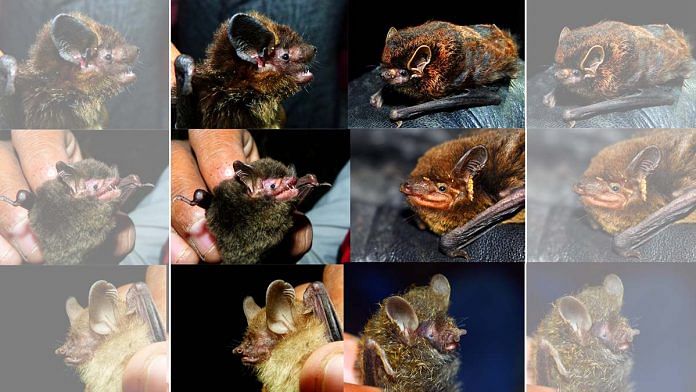Bengaluru: In a new echolocation survey of bats, scientists have identified 32 species in the western Himalayan region in Uttarakhand. Of these, the ultrasonic echolocation calls of nine species were recorded for the first time in the world while one was documented for the first time in South Asia.
Additionally, the researchers also sequenced genes belonging to 13 species, of which eight had never been sequenced before in the region. One such species was recorded for the first time in the Indian subcontinent.
The study was an international collaboration, conducted by researchers from the Nature Science Initiative in Dehradun, the Indian Institute of Science in Bengaluru, and the Natural History Museum of Geneva.
It was published in the journal Acta Chiropterologica this month.
In India, bats are the most diverse mammals with 128 species identified. However, their distribution, habitat, diversity, ecology, behaviour, and echolocation calls have not been well documented, with most bat surveys having been conducted in colonial India in the late 1800s. The Himalayan region particularly lacks this breadth of information.
Also read: Scientists identify chemical that makes locusts swarm, say it can help tackle pest plague
Study methods and details
This study was the first to document echolocation calls of bats in the Himalayas, which can be used to monitor populations, understand behaviour, and better understand natural history.
Chiroperologist Rohit Chakravarty-led study was conducted between 2015 and 2018 at 22 sites in Dehradun, Mussoorie, Devalsari, Dhanaulti, Chamba, Kedarnath Wildlife Sanctuary, Lansdowne, and Pangot in Nainital district in Kumaon region. These were locations at elevations from 600-3,000 m above sea level.
Individuals from a total of 35 species were humanely trapped and studied before being released back into the wild, according to the researchers.
“Bats are caught using mistnets and harp traps,” explained Chakravarty. “We typically handle bats wearing leather gloves (to prevent being bitten and also to not come in direct contact with them), except when they are handled from the back because it’s impossible to get a good grip on them with gloves.”
Since the study was conducted before the ongoing Covid outbreak, there were no global guidelines for handling bats for resect purposes, except for ethical guidelines on how to reduce stress to bats while handling them.
But, Chakravarty explained, guidelines exist for prevention of disease transmissions, both from bats to humans and from humans to bats, including using disposable sterile gloves for bat handling, wearing face masks and sanitising all equipment in between processing two different bats.
When a bat was captured, its echolocation call was recorded either in hand, upon release, or in brick-walled rooms. Many were also sequenced for their DNA from blood samples. The samples were then barcoded for record-keeping and appropriate identification.
Also read: Dwarf planet Ceres has ocean of salt water underneath its surface, NASA data studies show
Findings and their significance
Of the 32 echolocation calls that were recorded, nine were recorded for the first time in the world.
One of them was the Sombre bat, which is very rare in the region. Another notable species was the Long-tailed Whiskered bat, which is poorly understood globally as well. The latter likely comprises multiple species. It was also recorded for the very first time in South Asia over the course of this survey.
Echolocation libraries that record sounds made by the distinct species, just as DNA barcoding, are important to identify and monitor bat populations. Ultrasonic sounds are recorded through bat detectors, which can record sounds made by a wide range of species that use echolocation for navigation, without actually trapping the bats.
However, Chakravarty pointed out that such recordings can be used only when a reference library exists to compare the sounds with. Therefore, bats needed to be caught and their sounds identified first, as a baseline for future research.
Identifying bat species, habitat, and behaviour is an important part of monitoring animal populations, including for diseases, changes in habitat from climate change, documenting biodiversity, and for conservation.
Bats play a crucial role in a number of varied ecosystems, primarily through pollination, seed dispersal, and insect control. They also are an indicator of the impact of climate change and human activity on the environment, as their sensitivity to environmental changes is very high.
“Different animal species are known to shift their distributions to higher latitudes or elevations in response to climate change so we need present-day baseline distributions of different species in order to detect changes in their distributions in the future,” said Chakravarty.
India is also a signatory to the Convention on Biological Diversity, which mandates countries to prepare inventories of biodiversity.
These libraries of DNA barcodes and echolocation calls will now serve as a valuable database for future research into bat prevalence and monitoring in the country and subcontinent.
Also read: NASA is tracking a dent that’s slowly widening in Earth’s magnetic field




Yes i m from uttrakhand,and i can take you to there homes ,